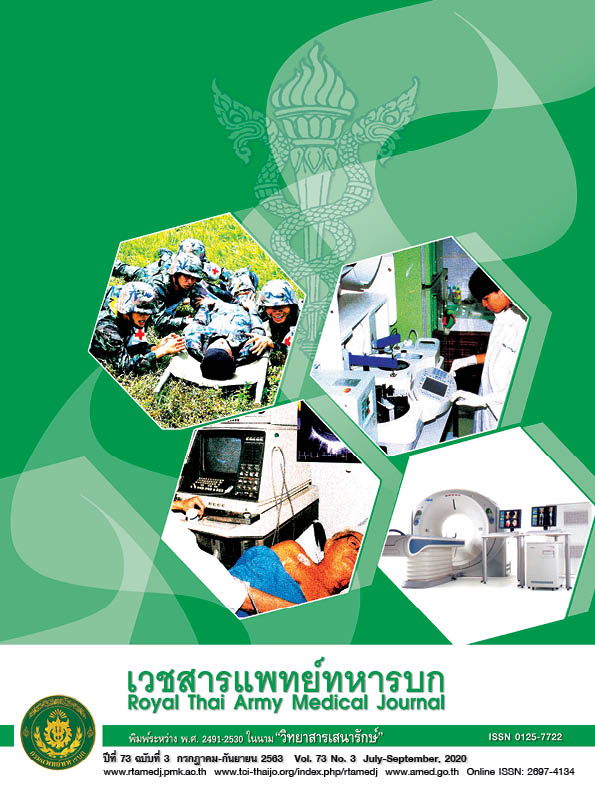ประสิทธิผลของการใช้แป้งผงโรยตัวในการป้องกันผื่นที่ขาหนีบในทหารเกณฑ์
Main Article Content
บทคัดย่อ
ภูมิหลังการศึกษา : ผื่นที่ขาหนีบจากโรคกลากที่ขาหนีบ(Tinea cruris) Intertrigo Erythrasma Candidiasis เป็นโรคผิวหนังที่พบได้บ่อยในทหาร แม้ผื่นที่ขาหนีบจะไม่ใช่โรคที่มีความรุนแรงถึงขั้นเสียชีวิตแต่ก็ส่งผลกระทบต่อประสิทธิภาพในการฝึกและคุณภาพชีวิตของทหาร ปัจจุบันประเทศไทยยังไม่มีการศึกษาประสิทธิผลของแป้งป้องกันผื่นที่ขาหนีบในบุคคลากรทหาร
วัตถุประสงค์ : 1.) เพื่อเปรียบเทียบอัตราอุบัติการณ์ของผื่นที่ขาหนีบระหว่างทหารเกณฑ์กลุ่มที่ใช้แป้งผงโรยตัว (กลุ่มทดลอง)และกลุ่มที่ใช้แป้งในท้องตลาด (กลุ่มควบคุม) และ2) เพื่อศึกษาอุบัติการณ์ของเหตุการณ์ไม่พึงประสงค์ในทหารเกณฑ์จากการใช้แป้งทั้งในกลุ่มทดลองและกลุ่มควบคุม
วิธีการ : การทดลองแบบสุ่มทั้งกลุ่มและมีกลุ่มควบคุม (cluster randomized controlled trial) ในหน่วยฝึกทหาร 11 หน่วยในกรุงเทพมหานคร โดยมีหน่วยฝึกทหารจำนวน 7 และ 4 หน่วย (ซึ่งมีทหารเกณฑ์จำนวน 937 และ 911 คนที่เข้าเกณฑ์และเข้าร่วมการศึกษา) ถูกจัดเป็นกลุ่มทดลองและกลุ่มควบคุม ทหารเกณฑ์ใช้แป้งเป็นระยะเวลา 10 สัปดาห์ โดยที่นายสิบพยาบาลในแต่ละหน่วยฝึกจะช่วยประเมินการเกิดผื่นที่ขาหนีบในทหารเกณฑ์ทุก 2 สัปดาห์ ทหารเกณฑ์ที่มีผื่นที่ขาหนีบจะถูกส่งไปตรวจและรักษาจากแพทย์เฉพาะทางโรคผิวหนังที่แผนกโรคผิวหนังโรงพยาบาลพระมงกุฎเกล้า
ผลการศึกษา : พบว่าในกลุ่มทดลองและกลุ่มควบคุมเกิดผื่นที่ขาหนีบ 217 และ 276 คนตามลำดับ โดยมีอัตราอุบัติการณ์ 23.16 และ 30.30 รายต่อ 100 คนต่อ 10 สัปดาห์ซึ่งแตกต่างกันอย่างมีนัยสำคัญทางสถิติ (p = 0.001) วิเคราะห์เพิ่มเติมโดยการควบคุมตัวแปรกวน (อายุ ระดับการศึกษา ประวัติของการติดเชื้อราก่อนหน้านี้และประวัติของการลงไปในน้ำในช่วงสองสัปดาห์ก่อนหน้า) ได้ค่า adjusted rate ratio (ช่วงความเชื่อมั่น 95%) เท่ากับ 0.76 (0.63 , 0.90) (p = 0.002) นอกจากนี้อาการแทรกซ้อนที่อาจเกิดขึ้นนั้นพบได้ไม่บ่อยในกลุ่มทดลองเมื่อเปรียบเทียบกับกลุ่มควบคุม
สรุป : แป้งผงโรยตัวป้องกันผื่นมีประสิทธิภาพในการป้องกันการเกิดผื่นที่ขาหนีบในทหารเกณฑ์ในประเทศไทย
Downloads
Article Details
บทความในวารสารนี้อยู่ภายใต้ลิขสิทธิ์ของ กรมแพทย์ทหารบก และเผยแพร่ภายใต้สัญญาอนุญาต Creative Commons Attribution-NonCommercial-NoDerivatives 4.0 International (CC BY-NC-ND 4.0)
ท่านสามารถอ่านและใช้งานเพื่อวัตถุประสงค์ทางการศึกษา และทางวิชาการ เช่น การสอน การวิจัย หรือการอ้างอิง โดยต้องให้เครดิตอย่างเหมาะสมแก่ผู้เขียนและวารสาร
ห้ามใช้หรือแก้ไขบทความโดยไม่ได้รับอนุญาต
ข้อความที่ปรากฏในบทความเป็นความคิดเห็นของผู้เขียนเท่านั้น
ผู้เขียนเป็นผู้รับผิดชอบต่อเนื้อหาและความถูกต้องของบทความของตนอย่างเต็มที่
การนำบทความไปเผยแพร่ซ้ำในรูปแบบสาธารณะอื่นใด ต้องได้รับอนุญาตจากวารสาร
เอกสารอ้างอิง
2. Bae JM, Ha B, Lee H, Park CK, Kim HJ, Park YM. Prevalence of common skin diseases and their associated factors among military personnel in Korea: a cross-sectional study. J Korean Med Sci 2012;27:1248-54.
3. Gan WH, Low R, Koh D. Dermatological conditions in military conscripts. Occup Med (Lond) 2013;63:435-8.
4. Sasmaz S, Celik M. Skin diseases in Turkish soldiers. Dermatol Sin 2011;29:44-6.
5. Gatt P, Pace J. Environmental skin diseases in military personnel. Clin Dermatol 2002;20:420-4.
6. Senel E, Dogruer Senel S, Salmanoglu M. Prevalence of skin diseases in civilian and military population in a Turkish military hospital in the central Black Sea region. J R Army Med Corps 2015;161:112-5.
7. Kaushik N, Pujalte GG, Reese ST. Superficial Fungal Infections. Prim Care 2015;42:501-16.
8. Kalra MG, Higgins KE, Kinney BS. Intertrigo and secondary skin infections. Am Fam Physician 2014;89:569-73.
9. Nobles T, Miller RA. Intertrigo. StatPearls. Treasure Island (FL): StatPearls Publishing
StatPearls Publishing LLC.; 2018.
10. Wolf R, Oumeish OY, Parish LC. Intertriginous eruption. Clin Dermatol 2011;29:173-9.
11. Schieke SM, Grag A. Superficial fungal infection. In: Goldsmith LA, Katz SI, Goldsmith BA, Paller AS, Leffell DJ, Wolff K, editors. Fitapatrick's dermatology in general medicine. 8th ed. New York: McGraw-Hill; 2012. p. 2278-328.
12. Leite Junior DP, Yamamoto AC, Martins ER, Teixeira AF, Hahn RC. Species of Candida isolated from anatomically distinct sites in military personnel in Cuiaba, Mato Grosso, Brazil. An Bras Dermatol 2011;86:675-80.
13. Dermnet New Zealand. Tinea cruris [internet]. 2003. [cited 2018 Nov 2]. Available from: https://www.dermnetnz.org/topics/tinea-cruris.
14. Ingordo V, Naldi L, Fracchiolla S, Colecchia B. Prevalence and risk factors for superficial fungal infections among Italian Navy Cadets. Dermatology 2004;209:190-6.
15. Keita S, Faye O, Traore A, Dicko A, Berthe S, Traore P, et al. Dermatitis of the folds in black Africans in Bamako, Mali. Int J Dermatol 2012;51 Suppl 1:37-40, 1-4.
16. Drug.com. Drug.com. Gold Bond; Medicated Body [internet]. 2018. [cited 2019 Jan 3]. Available from: https://www.drugs.com/cdi/gold-bond-medicated-body.html.
17. Souza AD, Strober BE. Topical therapy. In: Goldsmith LA, Katz SI, Goldsmith BA, Paller AS, Leffell DJ, Wolff K, editors. Fitapatrick's dermatology in general medicine. 8th ed. New York: McGraw-Hill; 2012. p. 2644-713.
18. Benbow M. Use of talcum powder. J Wound Care 2001;10:22.


